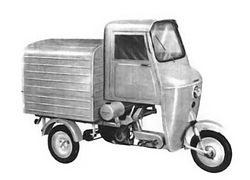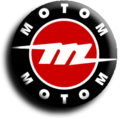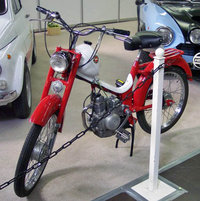Difference between revisions of "Motom"
m |
m |
||
| (8 intermediate revisions by the same user not shown) | |||
| Line 1: | Line 1: | ||
{{X}} | {{X}} | ||
| − | [[Image:logo_mov.jpg| | + | [[Image:logo_mov.png|center|120px]] |
| + | [[Image:637px-Motom_Moped_vl_bicolor_TCE.jpg|thumb|right|200px|'''Motom Moped VL''']] | ||
| − | |||
| Line 11: | Line 11: | ||
| − | Motom's first day of their | + | Motom's first day of their launch was at the ''[[Geneva]] Motor Show'' in 1947. The debut there showed the first creation of Motom, the Motomic (Atomic Motor). A modern legend was born, a light and robust bike with a single-cylinder 4-stroke engine, with incredible performance and low fuel consumption, this immediately guaranteed the popularity of Motom. |
| + | |||
| + | '''Motom''' stared to build the first multiple production motorcycle in 1948, this is a very original bike, with which it was anticipated that at least a decade of trends would support the technology of [[frames]] manufactured by pressed sheet metal bike structures. The frame consisted of a main truss at the front of the [[motorcycle]] that incorporated the [[gas tank]], while at the opposite side it divided the form of the two arms with rigid tubes that allowed room for the [[wheel]]. | ||
| + | |||
| + | In 1950, they presented the ''Dolphin'' 150, with a single [[cylinder]] engine tilted forward to a 147 cc head and valves with a four-speed [[transmission]]. The engine is housed far back, almost under the saddle, in a frame formed by the 'grand chamber' pipes. | ||
| + | |||
| + | In 1952, the 150 was replaced by the ''Delfino'' 163 cc with an increased power of 8 hp and speeds reaching 90 km/h. In 1953, the third model, the Motion ''Touring'' 98, with a frame formed by a central truss presses sheet metal that incorporated the gas tank. That same year, the GG 48 cc model was added to the lineup. 1952, the ''Motom Motocarro'' was introduced and was powered by a 48cc 4-stroke engine. This three wheeler vehicle had a motorcycle front end with the rear wheels being powered by a chain. The Motocarro was also sold under the ''[[Gavonis]]'' name and built until 1966. | ||
| − | '''Motom''' | + | [[File:Motom Motocarro.jpg|thumb|right|250px|An Early '''Motom Motocarro built from 1952 until 1966'''<br> The Motom introduced this novelty that would be a great success for their future, it was a motorized moped tricycle that could be driven without a [[motorcycle]] license: Full Load Capacity was 150 Kg (331 lbs)]] |
| − | In | + | In 1962, the ''Motomar'' Junior 100 was born, with the same general features of the Motomar 92, but with a 99.8 cc [[engine]]. Then came the moped 48 D in 1964 with a three gear transmission and the same year, the ''Motomar Peugeot'' went into production, which was built in collaboration with the French company ''Peugeot''. |
| − | + | The ''Nova'', in 1965, with a two-stroke engine and, on request, was avaliable with an automatic clutch. A year later, they entered in the ''Junior Cross'', off-road bike with 98 cc, followed by the ''Sport'' 50, with an engine of 48 cc. In 1967, the moped ''Daina'', with a [[two-stroke]] engine and automatic [[clutch]], now flanked by the ''Daina Matic'' with automatic variable speed. After a long run, the ''Motomar'', because of financial difficulties, was forced to cease its [[motorcycle]] production. | |
| Line 24: | Line 30: | ||
<gallery> | <gallery> | ||
| − | image:motom 48 c 61 depliant 2 2009.jpg|<font color= | + | image:motom 48 c 61 depliant 2 2009.jpg|<font color=>'''1961 Motom 48 C''' [http://www.motomanuali.com <small>Source</small>] |
| − | image:motom 48 d depliant 2009.jpg|<font color= | + | image:motom 48 d depliant 2009.jpg|<font color=>'''Motom 48 D''' [http://www.motomanuali.com <small>Source</small>] |
| − | image:motom 48 junior 63 depliant 2009.jpg|<font color= | + | image:motom 48 junior 63 depliant 2009.jpg|<font color=>'''1963 Motom 48 Junior''' [http://www.motomanuali.com <small>Source</small>] |
| − | image:motom 98 ts brochure.jpg|<font color= | + | image:motom 98 ts brochure.jpg|<font color=>'''Motom 98 TS''' [http://www.motomanuali.com <small>Source</small>] |
| − | image:motom nova depliant 2009.jpg|<font color= | + | image:motom nova depliant 2009.jpg|<font color=>'''Motom Nova''' [http://www.motomanuali.com <small>Source</small>] |
</gallery> | </gallery> | ||
<gallery> | <gallery> | ||
| − | image:1957 Motom 48ss Super Sport 1.jpg|<font color= | + | image:1957 Motom 48ss Super Sport 1.jpg|<font color=>'''1957 Motom 48ss Super Sport''' [http://www.fressonsportsmopeds.co.uk <small>Source</small>] |
| − | image:1957 Motom 48ss Super Sport 2.jpg|<font color= | + | image:1957 Motom 48ss Super Sport 2.jpg|<font color=>'''1957 Motom 48ss Super Sport''' [http://www.fressonsportsmopeds.co.uk <small>Source</small>] |
</gallery> | </gallery> | ||
Latest revision as of 22:22, 7 June 2012
1945 - 1971
Motom Italiana S.p.A. manufactured motorcycles and mopeds in Milano, Italy, from 1945 to 1971.
Motom's first day of their launch was at the Geneva Motor Show in 1947. The debut there showed the first creation of Motom, the Motomic (Atomic Motor). A modern legend was born, a light and robust bike with a single-cylinder 4-stroke engine, with incredible performance and low fuel consumption, this immediately guaranteed the popularity of Motom.
Motom stared to build the first multiple production motorcycle in 1948, this is a very original bike, with which it was anticipated that at least a decade of trends would support the technology of frames manufactured by pressed sheet metal bike structures. The frame consisted of a main truss at the front of the motorcycle that incorporated the gas tank, while at the opposite side it divided the form of the two arms with rigid tubes that allowed room for the wheel.
In 1950, they presented the Dolphin 150, with a single cylinder engine tilted forward to a 147 cc head and valves with a four-speed transmission. The engine is housed far back, almost under the saddle, in a frame formed by the 'grand chamber' pipes.
In 1952, the 150 was replaced by the Delfino 163 cc with an increased power of 8 hp and speeds reaching 90 km/h. In 1953, the third model, the Motion Touring 98, with a frame formed by a central truss presses sheet metal that incorporated the gas tank. That same year, the GG 48 cc model was added to the lineup. 1952, the Motom Motocarro was introduced and was powered by a 48cc 4-stroke engine. This three wheeler vehicle had a motorcycle front end with the rear wheels being powered by a chain. The Motocarro was also sold under the Gavonis name and built until 1966.

The Motom introduced this novelty that would be a great success for their future, it was a motorized moped tricycle that could be driven without a motorcycle license: Full Load Capacity was 150 Kg (331 lbs)
In 1962, the Motomar Junior 100 was born, with the same general features of the Motomar 92, but with a 99.8 cc engine. Then came the moped 48 D in 1964 with a three gear transmission and the same year, the Motomar Peugeot went into production, which was built in collaboration with the French company Peugeot.
The Nova, in 1965, with a two-stroke engine and, on request, was avaliable with an automatic clutch. A year later, they entered in the Junior Cross, off-road bike with 98 cc, followed by the Sport 50, with an engine of 48 cc. In 1967, the moped Daina, with a two-stroke engine and automatic clutch, now flanked by the Daina Matic with automatic variable speed. After a long run, the Motomar, because of financial difficulties, was forced to cease its motorcycle production.
Gallery
1961 Motom 48 C Source
Motom 48 D Source
1963 Motom 48 Junior Source
Motom 98 TS Source
Motom Nova Source
External Link
Send what you have to:
| Motorcycle Information and Photos by Marque: A - B - C - D - E - F - G - H - I - J - K - L - M - N - O - P - Q - R - S - T - U - V - W - X - Y - Z |
| Car Information and Photos by Marque: A - B - C - D - E - F - G - H - I - J - K - L - M - N - O - P - Q - R - S - T - U - V - W - X - Y - Z |








